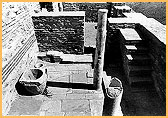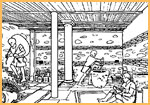|
Sardis, a major trade centre
Sardis was an important provincial capital, as
well as a military and  industrial
centre. The so-called Byzantine Shops of Sardis (about thirty
three in total) line the south wall of the vast Bath/Gymnasium
complex and give onto the main highway that led from Sardis
to eastern Anatolia. They provided a focus for commercial
life in the western part of the city, and demonstrate the
shift of retailing and small manufacture from the open squares
(agorae) to the colonnaded streets in the Early Byzantine
period. industrial
centre. The so-called Byzantine Shops of Sardis (about thirty
three in total) line the south wall of the vast Bath/Gymnasium
complex and give onto the main highway that led from Sardis
to eastern Anatolia. They provided a focus for commercial
life in the western part of the city, and demonstrate the
shift of retailing and small manufacture from the open squares
(agorae) to the colonnaded streets in the Early Byzantine
period.
The shops were sheltered under a long
portico which
at a late date (probably in the early fifth century) replaced
a earlier grander structure. A second similar portico stood
on the opposite side of the street. The modest new porticoes
were built of heterogenous spoils. The squat colonnades supported
a wooden
entablature
and roof, while an
ambulatory paved
with mosaics allowed access to the shops. The total width
of the street and porticoes exceeded 37 m. The shops consisted
of one or more units, and were often two-storeyed. Building
materials included reused marble blocks for the corners and
door jambs, mortared rubble and brick for the walls, and tiles
for the roof and the paving of the second-floor apartments.
Floors at ground level were normally of beaten earth, but
tile and stone were employed where heavy use was in question.
The Christian and Jewish proprietors of the Sardis shops manufactured
and sold a variety of goods, such as metal tools and utensils,
glass vessels (or their contents), dyes and dyed cloth, and
possibly jewellery. Some shops were restaurants, identified
from the presence of counters, benches for customers, abundant
kitchen wares, and sheep or goat bones. Vast numbers of copper
coins, typical small change' of the time, suggest continuing
use of the shops down to the early seventh century (the colonnade
was destroyed by fire in 616).
One of the dozens of shops (shop E6/E7) excavated
in recent years has been identified as a dye establishment.
 Two
menorahs carved on the door jamb seem to indicate that its
owner was Jewish, and graffiti on two amphora fragments name
a certain Jacob, possibly the owner himself. The shop's upper
storey was used for storage; the lower storey for the manufacture
of dyes. Both levels were lit by glass windows. Various instruments
and containers found scattered on the shop's floor, as well
as heaps of dyeing substance, indicate the shops activity.
Several mortars and pestles were used to grind the dyes, while
incense burning in a brass censer hung from the ceiling chased
away the fowl smells. Materials were weighed with
steelyards
and a small balance, and stored in terracotta pipes placed
on end by the stairs. Several cups and a self-heating copper
kettle were used by the workmen to make hot drinks. Other
implements, such as camp stool frames and lampstands, a knife,
a strainer, ceramic bowls and jugs, served common household
purposes. Two
menorahs carved on the door jamb seem to indicate that its
owner was Jewish, and graffiti on two amphora fragments name
a certain Jacob, possibly the owner himself. The shop's upper
storey was used for storage; the lower storey for the manufacture
of dyes. Both levels were lit by glass windows. Various instruments
and containers found scattered on the shop's floor, as well
as heaps of dyeing substance, indicate the shops activity.
Several mortars and pestles were used to grind the dyes, while
incense burning in a brass censer hung from the ceiling chased
away the fowl smells. Materials were weighed with
steelyards
and a small balance, and stored in terracotta pipes placed
on end by the stairs. Several cups and a self-heating copper
kettle were used by the workmen to make hot drinks. Other
implements, such as camp stool frames and lampstands, a knife,
a strainer, ceramic bowls and jugs, served common household
purposes.
< Despite their tawdry construction and uneven design,
the Byzantine Shops at Sardis were conceived as a unified
complex; extensive use of mosaic in the portico suggests some
degree of public authority behind the project. In this they
differ from contemporary and later commercial structures in
a number of cities (Ephesus, Side, Philippi, Corinth) where
private individuals encoarched on public space in a more haphazard
manner. A most striking example is provided by the city of
Caricin Grad, where a small artisan's quarter developped on
public and ecclesiastical space alike, inside the walls of
the upper city, in the late sixth century.
|